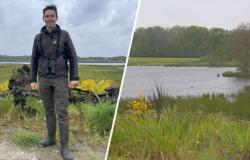NOS News•today, 00:27
-
Rolf Schuttenhelm
editor Climate
-
Rolf Schuttenhelm
editor Climate
The Netherlands can be completely climate neutral by 2050. But that feasibility is seriously compromised if we exclude or even postpone controversial measures. This is what the Netherlands Environmental Assessment Agency (PBL) says in a new calculation.
More than thirty routes to become climate neutral have been calculated for all important sectors. The PBL calls it their ‘flagship’. Together with background reports, it amounts to about a thousand pages.
“It is a huge task,” PBL director Marko Hekkert told NOS. “We only have 25 years left to achieve this. Any delay you allow yourself will either make it extremely expensive or impossible. So the main thing now is to persevere – we have already seen the urgency in recent years.”
Hekkert’s concern is short-term thinking. Some measures that can help achieve the 2030 climate target (55 percent fewer greenhouse gases than in 1990) may actually lead to stagnation in the long term. An example is heating houses with hydrogen.
“The sector is saying: there are nice natural gas pipelines – so we can put hydrogen in them. But if you look at the entire system, we need that hydrogen elsewhere, and heat pumps for heating appear to be much more optimal. So for the policy that we are now still make: put on the 2050 glasses.”
The PBL has investigated which scenarios are the most cost-effective, against relatively small changes in production and consumption. “We do not assume large-scale behavioral changes in the study,” says lead author Bart Strengers. His conclusion: it is not only feasible, but also affordable. “These are not astronomical amounts. It is mainly about a transition that we have to go through. That requires large investments and fair distribution – but does not entail high net costs.”
Dutch hydrogen and biokerosene
By 2050, no less than three to five times as much electricity will have to be produced in the Netherlands as now, from wind, sun and possibly some nuclear energy. Thanks to this extra electricity, road traffic, heating and industry can stop using fossil fuels.
Hydrogen also plays an important role in this – to absorb peaks in electricity supply and demand. According to the PBL, we will produce most of that hydrogen in the Netherlands ourselves. According to the planning agency, it is essential that various investments are carried out in parallel, and that there is no “waiting” for progress elsewhere.
Two difficult sectors that cannot be electrified are shipping and aviation. Shipping could switch to biofuel or ammonia, and aviation to biokerosene and synthetic kerosene.
Livestock decline
We must also produce this alternative aviation fuel ourselves (on a large scale) in the Netherlands. CO2 is released during production and if we store it underground, more CO2 is extracted from the atmosphere than is released.
These negative emissions will then be needed for the sector that is most difficult to make sustainable: agriculture. In the Netherlands, it now emits 23 million tons of greenhouse gases per year (15 percent of the total).
That will still be 9 to 12 million tons in 2050. This assumes some reduction in the livestock population, in line with the nitrogen policy. These remaining emissions from agriculture in particular will therefore have to be compensated in 2050.
No indulgence
Many other reports assume that such negative emissions can be created by burning biomass for electricity and storing the CO2 released underground.
The PBL sees this differently: excessive growth in demand can cause shortages and sustainability problems, including deforestation. Biomass should therefore only be used for high-value applications, such as raw material for bioplastics and construction, and biofuels for transport sectors that cannot electrify.
Storing CO2 underground is not an excuse to continue large-scale use of fossil fuels. According to the report, only a very small part of fossil fuels can be offset with CO2 storage in 2050.
Population growth
The report views population growth as a given and assumes moderate growth (one to two million additional people in 2050). This requires 1.4 million additional homes between 2020 and 2050. The actual volume of buildings in the Dutch landscape is growing almost twice as fast, due to a comparable increase in buildings for the service sector.
Yet the State Commission for Demographic Developments showed that population growth can in practice be significantly lower or higher, depending on immigration. If more people are added before 2050, it will become more difficult and easier if growth is lower, Hekkert acknowledges. In addition to agriculture and housing construction, the scarce space in the Netherlands is also needed for additional forests.
Tackling waste
Making lifestyles more sustainable can also make the task a lot easier. According to the PBL, further study is needed in this area; it is not included in this report. However, according to the planning agency, it is essential that we waste much less net energy. Only then will the additional CO2-free electricity be sufficient to replace all fossil fuels.
These savings come from good insulation of all homes and other buildings, says Bert Daniels, the second lead author. “But it is also in new technology. For example, heat pumps consume a net third to a quarter of the energy of gas heating and an electric car is roughly three times as efficient as a comparable combustion car.”
Ultimately it is a fairly simple story, Hekkert concludes. “All sustainability must be scaled up. You can’t do anything wrong, as long as you scale up.”
Tags: Netherlands work hard
-





